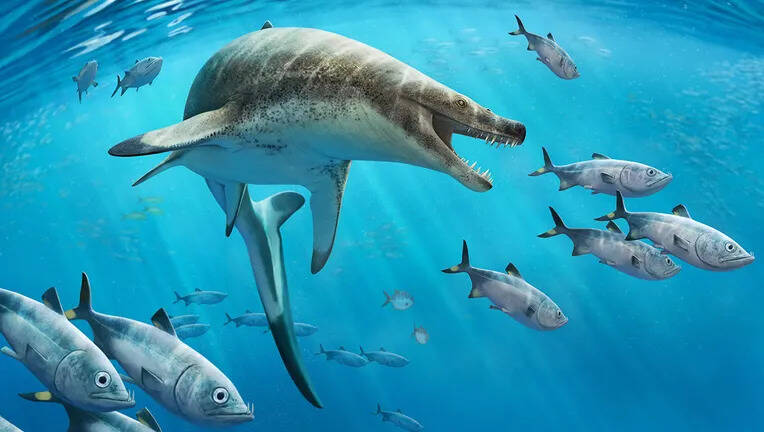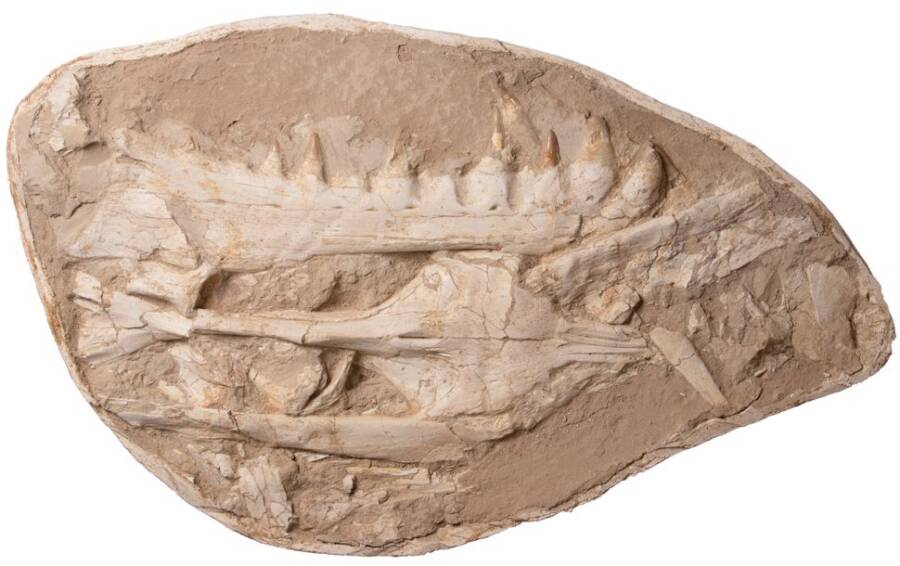The Khinjaria acuta had dagger-like teeth that helped it hunt prey off the coast of Africa 66 million years ago.

Andrey Atuchin/University of BathArtistic depiction of the Khinjaria acuta, the mosasaur that stalked the waters of the Late Cretaceous Period.
Researchers have uncovered the fossilized remains of a prehistoric giant lizard in a phosphate mine near Casablanca, Morocco.
Researchers believe the creature was aquatic and prowled the waters off the African coast during the Late Cretaceous Period nearly 66 million years ago.
The Khinjaria Acuta And Its Habitat
While excavating the phosphate mine, researchers uncovered the skull and parts of the skeleton of what appeared to be a prehistoric sea monster. Noting the creature’s dagger-like teeth, researchers named it Khinjaria acuta, stemming from Khinjar, the Arabic word for “dagger,” and acuta, the Latin word for “sharp.”
According to the team’s research, published in the journal Cretaceous Research, the reptile measured roughly 26 feet in length — about the size of an orca — and had formidable jaws that would have allowed it to hunt large prey.
“The elongation of the posterior part of the skull which accommodated the jaw musculature suggests a terrible biting force,” Nour-Eddine Jalil from the Museum National d’ Histoire Naturelle in Paris stated in the University of Bath’s press release about the discovery.

University of BathThe fossilized remains of the Khinjaria acuta.
This creature, referred to as “nightmarish” by researchers, belonged to the Mosasauridae family, an extinct group of lizards whose descendants include Komodo dragons and anacondas.
Although the Khinjaria came from a long line of similar aquatic predators, the sea monster’s distinct dagger-like teeth gave it an advantage in the waters of the Late Cretaceous period.
“Some mosasaurs had teeth to pierce prey, others to cut, tear, or crush,” said the lead study author Dr. Nick Longrich of the University of Bath. “Now we have Khinjaria, with a short face full of huge, dagger-shaped teeth. This is one of the most diverse marine faunas seen anywhere, at any time in history, and it existed just before the marine reptiles and the dinosaurs went extinct.”
Life In The Late Cretaceous Period
According to the University of Bath’s press release, the Khinjaria acuta would have competed fiercely for resources during its lifetime.
“What’s remarkable here is the sheer diversity of top predators,” said Dr. Longrich. “We have multiple species growing larger than a great white shark, and they’re top predators, but they all have different teeth, suggesting they’re hunting in different ways.”
“There seems to have been a huge change in the ecosystem structure in the past 66 million years,” Longrich continued. “This incredible diversity of top predators in the Late Cretaceous is unusual, and we don’t see that in modern marine communities.”
Like other Late Cretaceous creatures like the Tyrannosaurus rex and Triceratops, the Khinjaria acuta eventually disappeared as a result of the asteroid that crashed into the Yucatán peninsula.
The extinction of the mosasaurs and other prehistoric sea monsters allowed creatures like whales, seals, and modern fish to flourish. However, it posed an intriguing question about our planet’s oceans.
“Modern ecosystems have predators like baleen whales and dolphins that eat small prey, and not many things eating large prey,” Dr. Longrich stated. “The Cretaceous has a huge number of marine reptile species that take large prey. Whether there’s something about marine reptiles that caused the ecosystem to be different, or the prey, or perhaps the environment, we don’t know. But this was an incredibly dangerous time to be a fish, a sea turtle, or even a marine reptile.”
After reading about Khinjaria acuta, discover the story of Quetzalcoatlus, the largest flying dinosaur ever found. Then, read about the mass extinction event that killed the dinosaurs.





